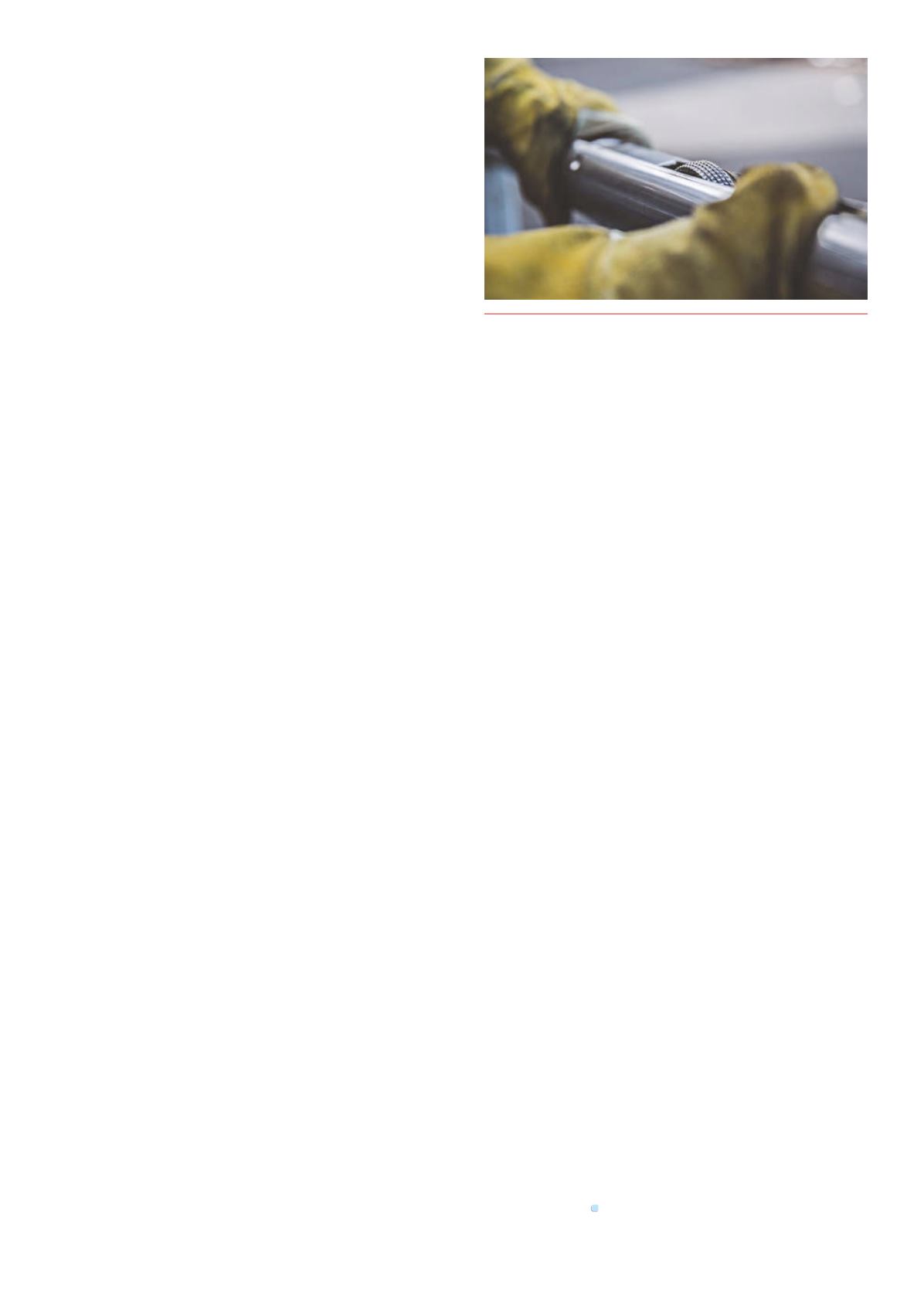
June
2015
Oilfield Technology
|
71
height from the swab valve (at closed position) to the top lubricator
part was only 52 ft.
Thus the newly designed, two‑wheel drive section configured
Well Tractor CR was ideal for this operation. The toolstring was
rigged‑up securely and conveyed to the target depth at 15 886 ft
where the Well Stroker® was activated and successfully pulled the
deep‑set plug. The job was completed after only one run of 16 hours.
The A safe rig up/rig down was enabled with the appropriate well
barriers in place.
Casestudy3
At an offshore platform, the rig‑up height was planned to be
just under 50 ft. The objective of the operation was to perform a
production logging over two zones in the well in order to establish
where produced water was coming from. Depending on these
results, one of these zones would then be isolated. Due to the
limited rig‑up height, the ideal conveyance solution was the
Well Tractor CR.
Total length of the applied toolstring was 47.6 ft, including the
Well Tractor CR and the third party PLT string. The PLT was conveyed
to a total depth of 11 940 ft at such a high speed it outperformed the
winch that was set up at 105 ft/min.
The operator achieved enough data to make an informed decision
on how to proceed and it was determined not to isolate any zones
by installing a plug. Risks were significantly reduced as considerably
fewer people were required on location.
Otherupdates
Parallel to the updates to the Well Tractor, the e‑line Well Stroker for
mechanical operations has also received numerous updates that can
help provide operators additional lightweight intervention options for
heavy duty mechanical jobs.
The newest Well Stroker XXS is designed to provide the required
force for most mechanical intervention operations, with the ability
to push or pull several times during the same run regardless of well
depth or lateral deviation.
When slickline solutions during operations in Norway failed for
operators, the Well Stroker was redesigned to fit operator needs: The
tool was improved to apply up to 60 000 lb of axial force downhole.
It uses a bi‑directional hydraulic ram to push and pull after several
anchors affix the tool to the wellbore. Additionally, significant safety
features ensure that operators never have to kill the well if problems
arise, providing a degree of operational insurance.
The Well Stroker XXS can be deployed via the Well Tractor or run
directly on e‑line and it can provide services to vertical, horizontal and
extended reach wells. It has been used in some recent operations in
the North Sea.
Casestudy4
On a North Sea offshore well, an operator experienced a problem
when a plug and setting tool accidently set across the Christmas tree
and blowout preventer, thus eliminating them from being an effective
barrier for the well. This issue placed personnel, equipment, and the
environment at significant risk.
The operator first attempted to retrieve the plug using slickline
with two jars in the string: a hydraulic jar with accelerator for up
stroking and a mechanical jar for down stroking. The setting tool
and plug could not be retrieved by this method because slickline
had insufficient pull force. Additionally, the operator could not
release the plug and the setting tool in one run due to a failing jar.
The e‑line Well Stroker XXS was chosen when it became clear that
slickline would not work.
The system sheared the shear pins with 45 000 lb of force during
the first run. The operator then retrieved the setting tool, confirming
the completed setting process. The total operation consisted of
three runs, with no misruns. The system was able to first set the plug
before pulling it. Prolonged exposure to HSE risks was prevented.
Casestudy5
Offshore North Sea the operating company encountered a
malfunctioning setting tool during an e‑line operation, which led to
a partially set plug and a stuck tool. Fishing equipment on braided
wire attempted to fish the tool, making 207 jar attempts. Analysis
estimated that 40 000 lb of pull force would shear the stud and free
the setting tool.
Despite the worn fishing neck, the system latched on the fourth
attempt, sheared the stud, and completed the setting sequence.
The operator saved five days of rig time and avoided the costs of an
expensive workover rig.
E‑lineas theprimaryoption
Both of these cases demonstrate the potential of the Well Stroker XXS
to outperform traditional workover interventions such as slickline.
In fact, the system has also been used to fix problems caused by the
initial application of slickline.
E‑line tools and interventions have often been relegated to
contingency plans with traditional, heavier workovers being the
primary approach. However the Well Stroker XXS’s increased pull
makes e‑line mechanical interventions a viable alternative to heavy
workovers like coiled tubing and hydraulic workover and other
traditional methods like slickline. It can be argued that these e‑line
solutions should be preferred when considering the HSE benefits and
lower financial risk for operators.
Further improvements are imminent with the pending release of
the new Well Stroker XXS with the ability to apply 100 000 lb of force,
making e‑line mechanical solutions superior to alternative, heavier,
more expensive options, especially in today’s economic climate.
Conclusion
The economics of every field, especially mature fields, have to be
considered critically. Under the burden of lower commodity prices,
e-line interventions provide operators significant value with effective
tools and reliable operations that enable better production at lower
cost. Innovation, efficiency and reliability are the keys to lower cost and
higher profitability in today’s industry. Downhole solutions and their
complementary tools such as the Well Tractor and Well Stroker XXS
directly demonstrate examples of the value which can be achieved via
these key elements.
Figure 3.
Small size simplifies logistics, improves safety and increases
efficiency for a higher ROI.


